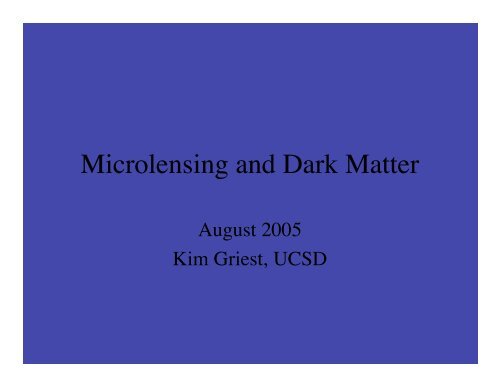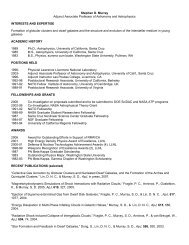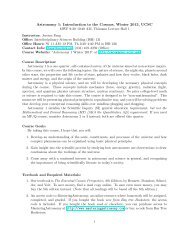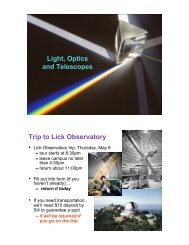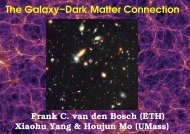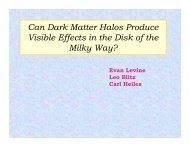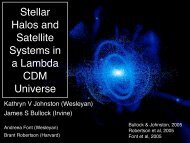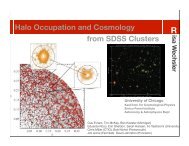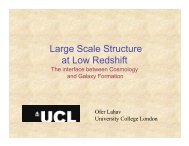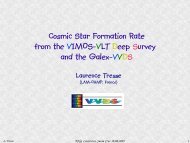Kim Griest
Kim Griest
Kim Griest
You also want an ePaper? Increase the reach of your titles
YUMPU automatically turns print PDFs into web optimized ePapers that Google loves.
Microlensing and Dark Matter<br />
August 2005<br />
<strong>Kim</strong> <strong>Griest</strong>, UCSD
•Surveys monitor millions of<br />
stars for years to find<br />
rare lensing events<br />
• Bulge => stars, remnants,<br />
planets, etc.<br />
•LMC/SMC/M31 => DM
Executive Summary<br />
• Basic Result: Searches done and show bulk<br />
of DM cannot be in compact objects with<br />
masses between Mars mass and 100 Msun<br />
• Conflicting results on whether ANY halo<br />
DM can exist in this form: 2 collaborations<br />
say yes, 2 say no<br />
• IF measurable amount of Macho halo DM<br />
exists, it would be a major new component<br />
of MW (and M31) => important<br />
consequences for galaxy formation and<br />
evolution
MACHO Collaboration (2000)<br />
• Monitored 11.9 million stars for 5.7 years<br />
• Found 13-17 events (depending on selection criteria)<br />
• Careful efficiency analysis including blending<br />
• Removed 8 Supernova behind LMC (contaminants)<br />
• Distribution in space, CMD, Amax, consistent with<br />
microlensing interpretation<br />
• Likelihood analysis to measure Macho DM, plus<br />
events in disk, LMC, etc.
LMC in<br />
neutral H<br />
looks like<br />
a face-on<br />
disk.
Test of<br />
systematic<br />
error due to<br />
contamination,<br />
selection bias:<br />
compare A<br />
B criteria<br />
Criteria A:<br />
tighter cuts,<br />
with less<br />
contamination<br />
Criteria B:<br />
looser cuts,<br />
with more<br />
contamination
•Masses 0.1 -<br />
1.0 Msun<br />
preferred<br />
•Halo fraction 8%<br />
- 40% preferred<br />
•Total mass in<br />
Machos: 8-10<br />
10^10 Msun<br />
(MW disk=6<br />
10^10 Msun, and<br />
MW halo has 4-6<br />
10^11 Msun)<br />
•Optical depth =<br />
1.2+0.4-0.3 10^-7
• Main conclusion: Macho’s as main<br />
component of Dark Matter are ruled out<br />
• But found significant extra microlensing
The number of non-Macho events is predicted to be much<br />
smaller than the 13-17 events observed (using standard LMC<br />
and Milky Way stellar populations.)
But these results need correcting<br />
• Recently EROS (Glicenstein 2004) found that<br />
event LMC-23 bumped again after 7 years =><br />
variable star, not lensing.<br />
• LMC-23 contributed 8% of optical depth (and<br />
halo fraction) (6% for set B), so all our optical<br />
depths and halo fractions should be reduced at<br />
least 8%.<br />
• => best f = 18.5%, and tau=1.1 10^-7 (<strong>Griest</strong> &<br />
Thomas), or f=16%, tau=1 10^-7 (Bennett)<br />
• More worrying: are there more events like this?
LMC-23
What does extra LMC<br />
microlensing mean?<br />
1. If events are in MW halo =><br />
- significant portion of DM<br />
- problem exists: What are they?<br />
-- stellar mass but can’t be stars (stars shine!)<br />
-- stellar remnant (white dwarfs, black holes) would need<br />
lots of early stars: no evidence for these (metal<br />
enrichment, background light, etc.) WD observed?<br />
-- primordial black holes? quark nuggets?<br />
2. If events are LMC self lensing =><br />
- current LMC models wrong?<br />
- lens stars should be seen?<br />
3. Contamination in MACHO dataset?
Much written on LMC self lensing since Sahu/Wu/Gould 1994<br />
•MACHO used Gyuk, Dalal, <strong>Griest</strong> review of LMC models, valid in<br />
2000, to predict 1-2 LMC self-lensing microlensing events. At that<br />
time no evidence of other stellar populations to do the self lensing.<br />
•HOW ABOUT RECENT EVIDENCE?<br />
•Zhao, Ibata, Lewis, & Irwin(2003) did 1300 2dF radial velocities:<br />
no evidence for any extra population over expected LMC and<br />
Galaxy<br />
Any new kinematically distinct population less than 1%.<br />
(rules out Evans & Kerrins 2000 fluffy stellar halo model)
• Gallart, Stetson, Hardy, Pont, & Zinn (2004), search for a stellar<br />
population in a deep surface brightness CMD, and found no<br />
evidence for any stellar halo<br />
• However, Minniti, et al (2003), and Alves (2004) found RVs for 43<br />
RR Lyaes and discovered an old and hot stellar halo! But they say<br />
it is too small to account for all the extra microlensing<br />
• But the structure of the LMC is being questioned: van der Marel,et<br />
al (2002) says the LMC disk is not circular, but Nikolaev, et al.<br />
(2004) disagree, saying it is warped. Both say it does not probably<br />
affect self lensing much (e.g. Mancinit etal 2003 agree), but it does<br />
show the LMC is still not well understood.<br />
• Summary: no clear answer yet
Contamination?<br />
• Contamination was studied by MACHO; selection<br />
criteria:<br />
A: 13 events, tight cuts, less contamination., lower effs<br />
B: 17 events, loose cuts, more contam., higher effs<br />
tau(A) =1.1e-7, tau(B)=1.3e-7.<br />
17% difference estimates contamination systematics<br />
• But Belokurov, Evans, & LeDu used neural net to<br />
reanalyze MACHO LMC data. Say data set is badly<br />
contaminated; find only 6 or 7 microlensing events =><br />
tau much smaller => no need for either Machos in dark<br />
halo or extra LMC self lensing!
Wrong!<br />
• Found events by running only on our selected events, but<br />
calculated efficiencies without including effect of our<br />
selection => badly miscalculated efficiencies.<br />
• Analyzed only 22000 lightcurves out of 11.9 million<br />
• Also used very weak statistics => much lower eff, and<br />
many false positives (2 out of 22000) => probably would<br />
not even work if applied to all 11.9 million lightcurves<br />
• Rejected good microlensing, misidentified SN<br />
Conclusion: BEL analysis is meaningless; neural nets<br />
may be useful, but have yet to be applied correctly.<br />
Contamination possible, but certainly not shown yet.<br />
Results of MACHO LMC5.7 stand after small correction<br />
for LMC-23.
What do to?<br />
Other experiments!
EROS collaboration: 4 events in 50 LMC fields and 4 events in<br />
10 SMC fields: Interpreted as limit on Halo dark matter<br />
LMC<br />
Events
Combined MACHO and EROS limits on short duration = small<br />
mass objects
Limits vary<br />
according to<br />
Milky Way halo<br />
model
LMC Limits on Macho Dark<br />
Matter<br />
• MACHO plus published EROS: Objects with 10 -7<br />
< m < 10 -3 Msun make up less than 25% of DM.<br />
Objects with 3.5 10 -7 < m < 4.5 10 -5 make up less<br />
than 10% of DM<br />
• EROS conference proceedings: (3 events from 33<br />
million stars over 100 sq deg)<br />
Objects with 10 -4 < m < 10 0 Msun make up less<br />
than 12% of DM (best fit Macho halo fraction of<br />
3%). (astro-ph/0501584) (CONFLICTS WITH<br />
MACHO RESULT)
• M31 microlensing is the new frontier<br />
(and site of new controversies!)<br />
• At least 4 groups have returned results<br />
(but situation not clarified!)<br />
• Key idea was to use M31 inclination and<br />
near/far asymmetry: if Macho halo, many<br />
more events should appear on far side of<br />
M31
MEGA:<br />
M31 Microlensing<br />
Found 4 events:<br />
Measure Macho<br />
halo fraction<br />
f=0.29 +0.30 -0.13<br />
.01< m < 1 Msun<br />
=> M31 halo<br />
DM consistent<br />
With LMC result!<br />
BUT POINT-<br />
AGAPE M31<br />
3 events says<br />
f
More recently: reversal!<br />
• POINT/AGAPE has 6 events; model M31; say more<br />
than self-lensing: halo fraction: f >20% for .5
Other M31 results<br />
• WeCAPP (Wendelstein Calar Alto<br />
Pixellensing project) found 2 events toward<br />
M31. Say favor M31 halo lenses, but<br />
evidence very weak (in my opinion).<br />
• Nainital group found one M31 event (on far<br />
side), no conclusions.
What does it mean?<br />
• Experimentally not clear: need more M31 work<br />
(MEGA/POINT-AGAPE, etc); Supermacho on LMC.<br />
From space can do parallax and (if approved) can answer<br />
question of where lenses are; eventually SIM and do<br />
astrometric microlensing. (Measure distance to 2 or 3<br />
LMC lenses as 10 kpc to prove Macho DM. 3 or 4 at 50<br />
kpc proves LMC self-lensing.) Need better modeling of<br />
M31.<br />
• Exciting current event: Spitzer IR satellite project<br />
approved to get parallax (Gould et al). Currently following<br />
an SMC event. Very likely to get distance.<br />
• Theoretically: Macho DM consistent with<br />
Omega_baryon = 0.04, but causes problems with star and<br />
galaxy formation, or requires very exotic objects.
BULGE<br />
Microlensing:<br />
three<br />
collaborations<br />
returned<br />
results:<br />
OGLE, EROS, MACHO<br />
Results now very consistent<br />
With modern models of the<br />
Milky Way (e.g. Bissant &<br />
Gerhard; Han & Gould)
Microlensing towards bulge<br />
• 50 million stars over 7 years<br />
• >450 events, 60 on clump giants (less blended)<br />
• ~40 binary events, parallax, extended source,<br />
lensing of variable stars, etc.<br />
• Optical depth = 2.18 +.45-.38 10 -6 , agrees with<br />
models (e.g. Gould and Han 1.63 10 -6 )<br />
• Also found optical depth as a function of (b,l)<br />
and gradient in optical depth
34 candidate<br />
events probably<br />
from the<br />
recently<br />
discovered<br />
Sagitarious<br />
dwarf galaxy
The first planet to be discovered by microlensing: OGLE 2003-BLG-233/<br />
MOA 2003-BLG-53; q=.0039. Likely star mass of 0.4 Msun, likely<br />
Planet mass of 1.5 M_jupiter.<br />
Second planet found in June (OGLE-2005-BLG-071).<br />
0.05 < m/M_jupiter < 4, at distance of several kpc; very high S/N
Conclusion<br />
• The mystery of LMC/M31 microlensing is still unsolved,<br />
and more work is needed<br />
• If you want an inventory of all compact objects,<br />
independent of luminosity microlensing is the way to go,<br />
i.e. Microlensing has a bright future for finding dark<br />
objects


